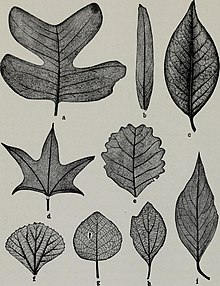Liriodendron

Liriodendron /ˌlaɪriəˈdɛndrən, ˌlɪr-, -ioʊ-/[1][2] is a genus of two species of characteristically large trees, deciduous over most of their populations, in the magnolia family (Magnoliaceae).
These trees are widely known by the common name tulip tree or tuliptree for their large flowers superficially resembling tulips. It is sometimes referred to as tulip poplar or yellow poplar, and the wood simply as “poplar”, although not closely related to the true poplars. Other common names include canoewood, saddle-leaf tree, and white wood.
The botanical name Liriodendron tulipifera originates from Greek: Liriodendron, which means lilytree, and tulipifera which means “bringing forth tulips”, alluding to the resemblance of its flowers to a tulip.
The two extant species are Liriodendron tulipifera, native to eastern North America and Liriodendron chinense, native to China and Vietnam. Both species often grow to great size, the North American species may reach as much as 58.5 m (192 ft) in height.[3] The North American species is commonly used horticulturally, the Chinese species is increasing in cultivation, and hybrids have been produced between these two allopatrically distributed species.
Various extinct species of Liriodendron have been described from the fossil record.
Liriodendron trees are easily recognized by their leaves, which are distinctive, having four lobes in most cases and a cross-cut notched or straight apex. Leaf size varies from 8–22 cm long and 6–25 cm wide. The tulip tree is often a large tree, 18–60 m high and 60–120 cm in diameter. The tree is known to reach the height of 191.8 feet (58.49 meters),[4] in groves where they compete for sunlight, somewhat less if growing in an open field. Its trunk is usually columnar, with a long, branch-free bole forming a compact, rather than open, conical crown of slender branches. It has deep roots that spread widely.[5]
